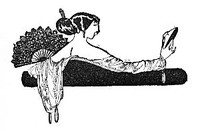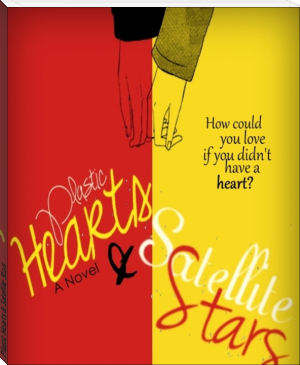Behind the Beyond, and Other Contributions to Human Knowledge, Stephen Leacock [online e reader .TXT] 📗

- Author: Stephen Leacock
Book online «Behind the Beyond, and Other Contributions to Human Knowledge, Stephen Leacock [online e reader .TXT] 📗». Author Stephen Leacock
No one, I think—not even my friend from Kansas who boasted that he had "put in" three hours at Versailles—could see all that is within the Château. But there are certain[135] things which no tourist passes by. One of them is the suite of rooms of Louis XIV, a great series of square apartments all opening sideways into each other with gilded doors as large as those of a barn, and with about as much privacy as a railway station. One room was the King's council chamber; next to this, a larger one, was the "wig-room," where the royal mind selected its wig for the day and where the royal hair-dresser performed his stupendous task. Besides this again is the King's bedroom. Preserved in it, within a little fence, still stands the bed in which Louis XIV died in 1715, after a reign of seventy-two years. The bedroom would easily hold three hundred people. Outside of it is a great antechamber, where the courtiers jealously waited their turn to be present at the King's "lever," or "getting up," eager to have the supreme honour of holding the royal breeches.
But if the King's apartments are sumptuous, they are as nothing to the Hall of Mirrors, the showroom of the whole palace, and esti[136]mated to be the most magnificent single room in the world. It extends clear across the end of the rear wing and has a length of 236 feet. It is lighted by vast windows that reach almost to the lofty arch that forms its ceiling; the floor is of polished inlaid wood, on which there stood in Louis the Great's time, tables, chairs, and other furniture of solid silver. The whole inner side of the room is formed by seventeen enormous mirrors set in spaces to correspond in shape to the window opposite, and fitted in between with polished marble. Above them runs a cornice of glittering gilt, and over that again the ceiling curves in a great arch, each panel of it bearing some picture to recall the victories of the Grand Monarch. Ungrateful posterity has somewhat forgotten the tremendous military achievements of Louis XIV—the hardships of his campaign in the Netherlands in which the staff of the royal cuisine was cut down to one hundred cooks—the passage of the Rhine, in which the King actually crossed the river from one side to the other, and so on. But the[137] student of history can live again the triumphs of Louis in this Hall of Mirrors. It is an irony of history that in this room, after the conquest of 1871, the King of Prussia was proclaimed German Emperor by his subjects and his allies.
But if one wants to see battle pictures, one has but to turn to the north wing of the Château. There you have them, room after room—twenty, thirty, fifty roomsful—I don't know how many—the famous gallery of battles, depicting the whole military history of France from the days of King Clovis till the French Revolution. They run in historical order. The pictures begin with battles of early barbarians—men with long hair wielding huge battle-axes with their eyes blazing, while other barbarians prod at them with pikes or take a sweep at them with a two-handed club. After that there are rooms full of crusade pictures—crusaders fighting the Arabs, crusaders investing Jerusalem, crusaders raising the siege of Malta and others raising the siege of Rhodes; all very picturesque, with the blue Mediter[138]ranean, the yellow sand of the desert, prancing steeds in nickel-plated armour and knights plumed and caparisoned, or whatever it is, and wearing as many crosses as an ambulance emergency staff. All of these battles were apparently quite harmless, that is the strange thing about these battle pictures: the whole thing, as depicted for the royal eye, is wonderfully full of colour and picturesque, but, as far as one can see, quite harmless. Nobody seems to be getting hurt, wild-looking men are swinging maces round, but you can see that they won't hit anybody. A battle-axe is being brought down with terrific force, but somebody is thrusting up a steel shield just in time to meet it. There are no signs of blood or injury. Everybody seems to be getting along finely and to be having the most invigorating physical exercise. Here and here, perhaps, the artist depicts somebody jammed down under a beam or lying under the feet of a horse; but if you look close you see that the beam isn't really pressing on him, and that the horse is not really stepping on his stomach. In fact the man is per[139]fectly comfortable, and is, at the moment, taking aim at somebody else with a two-string crossbow, which would have deadly effect if he wasn't ass enough to aim right at the middle of a cowhide shield.
You notice this quality more and more in the pictures as the history moves on. After the invention of gunpowder, when the combatants didn't have to be locked together, but could be separated by fields, and little groves and quaint farm-houses, the battle seems to get quite lost in the scenery. It spreads out into the landscape until it becomes one of the prettiest, quietest scenes that heart could wish. I know nothing so drowsily comfortable as the pictures in this gallery that show the battles of the seventeenth century,—the Grand Monarch's own particular epoch. This is a wide, rolling landscape with here and there little clusters of soldiers to add a touch of colour to the foliage of the woods; there are woolly little puffs of smoke rising in places to show that the artillery is at its dreamy work on a hill side; near the foreground is a small group[140] of generals standing about a tree and gazing through glasses at the dim purple of the background. There are sheep and cattle grazing in all the unused parts of the battle, the whole thing has a touch of quiet, rural feeling that goes right to the heart. I have seen people from the ranching district of the Middle West stand before these pictures in tears.[Illus]
 Personally I plead guilty to something of the same spirit.
Personally I plead guilty to something of the same spirit.
It is strange to compare this sort of thing with some of the modern French pictures. There is realism enough and to spare in them. In the Salon exhibition a year or two ago, for instance, there was one that represented lions turned loose into an arena to eat up Christians. I can imagine exactly how a Louis Quatorze artist would have dealt with the subject,—an arena, prettily sanded, with here and there gooseberry bushes and wild gilly flowers (not too wild, of course), lions with flowing manes, in noble attitudes, about to roar,—tigers, finely developed, about to spring,—Christians just going to pray,—and through it all a genial open-air feeling very soothing to the royal senses. Not so the artist of to-[141]day. The picture in the Salon is of blood. There are torn limbs gnawed by crouching beasts, as a dog holds and gnaws a bone; there are faces being torn, still quivering, from the writhing body,—in fact, perhaps after all there is something to be said for the way the Grand Monarch arranged his gallery.
The battle pictures and the Hall of Mirrors, and the fountains and so on, are, I say, the things best worth seeing at Versailles. Everybody says so. I really wish now that I had seen them. But I am free to confess that I am a poor sightseer at the best. As soon as I get actually in reach of a thing it somehow dwindles in importance. I had a friend once, now a distinguished judge in the United States, who suffered much in this way. He travelled a thousand miles to reach the World's Fair, but as soon as he had arrived at a comfortable hotel in Chicago, he was unable to find the energy to go out to the Fair grounds. He went once to visit Niagara Falls, but failed to see the actual water, partly because it no[142] longer seemed necessary, partly because his room in the hotel looked the other way.
Personally I plead guilty to something of the same spirit. Just where you alight from the steam tramway at Versailles, you will find close on your right, a little open-air café, with tables under a trellis of green vines. It is as cool a retreat of mingled sun and shadow as I know. There is red wine at two francs and long imported cigars of as soft a flavour as even Louis the Fourteenth could have desired. The idea of leaving a grotto like that to go trapesing all over a hot stuffy palace with a lot of fool tourists, seemed ridiculous. But I bought there a little illustrated book called the Château de Versailles, which interested me so extremely that I decided that, on some reasonable opportunity, I would go and visit the place.
[143]
V.—Paris at Night"WHAT Ah'd like to do," says the Fat Lady from Georgia, settling back comfortably in her seat after her five-dollar dinner at the Café American, while her husband is figuring whether ten francs is enough to give to the waiter, "is to go and see something real wicked. Ah tell him (the word 'him' is used in Georgia to mean husband) that while we're here Ah just want to see everything that's going."
"All right," says the Man from Kansas who "knows" Paris, "I'll get a guide right here, and he'll take us round and show us the sights."
"Can you get him heah?" asks the gentleman from Georgia, looking round at the glittering mirrors and gold cornices of the restaurant.
Can you get a guide? Well, now! Can you keep away from them? All day from the[144] dewy hour of breakfast till late at night they meet you in the street and sidle up with the enquiry, "Guide, sir?"
Where the Parisian guide comes from and how he graduates for his job I do not know. He is not French and, as a rule, he doesn't know Paris. He knows his way to the Louvre and to two or three American bars and to the Moulin Rouge in Montmartre. But he doesn't need to know his way. For that he falls back on the taxi-driver. "Now, sir," says the guide briskly to the gentleman who has engaged his services, "where would you like to go?" "I should like to see Napoleon's tomb." "All right," says the guide, "get into the taxi." Then he turns to the driver. "Drive to Napoleon's tomb," he says. After they have looked at it the guide says, "What would you like to see next, sir?" "I am very anxious to see Victor Hugo's house, which I understand is now made open to the public." The guide turns to the taxi man. "Drive to Victor Hugo's house," he says.
After looking through the house the visitor[145] says in a furtive way, "I was just wondering if I could get a drink anywhere in this part of the town?" "Certainly," says the guide. "Drive to an American bar."
Isn't that simple? Can you imagine any more agreeable way of earning five dollars in three hours than that? Of course, what the guide says to the taxi man is said in the French language, or in something resembling it, and the gentleman in the cab doesn't understand it. Otherwise, after six or seven days of driving round in this way he begins to wonder what the guide is for. But of course, the guide's life, when you come to think of it, is one full of difficulty and danger. Just suppose that, while he was away off somewhere in Victor Hugo's house or at Napoleon's grave, the taxi-driver were to be struck by lightning. How on earth would he get home? He might, perhaps, be up in the Eiffel Tower and the taxi man get a stroke of paralysis, and then he'd starve to death trying to find his way back. After all, the guide has to have the kind of pluck and hardihood that ought to be[146] well rewarded. Why, in other countries, like Switzerland, they have to use dogs





Comments (0)